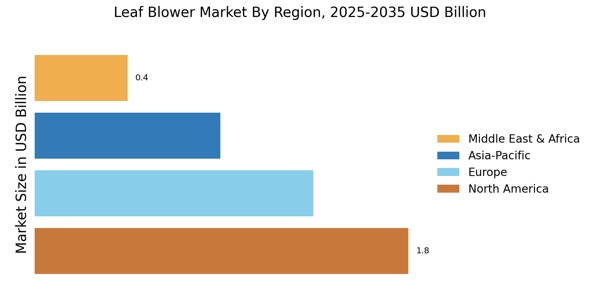Growing Environmental Awareness
The Leaf Blower Market is experiencing a notable shift as consumers become increasingly aware of environmental issues. This heightened consciousness has led to a growing preference for electric leaf blowers, which are perceived as more eco-friendly compared to their gas-powered counterparts. As a result, manufacturers are focusing on developing products that minimize emissions and noise pollution. According to recent data, the demand for electric models has surged, with sales projected to account for over 60% of the market by 2026. This trend not only reflects consumer preferences but also aligns with regulatory measures aimed at reducing carbon footprints. Consequently, companies that prioritize sustainability in their product offerings are likely to gain a competitive edge in the Leaf Blower Market.
Expansion of E-commerce Platforms
The Leaf Blower Market is witnessing a transformation due to the expansion of e-commerce platforms. As online shopping becomes increasingly prevalent, consumers are more inclined to purchase leaf blowers through digital channels. This shift is driven by the convenience and accessibility that e-commerce offers, allowing customers to compare products and prices easily. Recent data suggests that online sales of outdoor power equipment, including leaf blowers, have seen a significant uptick, with projections indicating that e-commerce could account for nearly 30% of total sales in the coming years. This trend not only benefits consumers but also presents opportunities for manufacturers to reach a broader audience. As e-commerce continues to grow, the Leaf Blower Market is likely to adapt to changing consumer purchasing behaviors.
Rising Urbanization and Landscaping Needs
The Leaf Blower Market is being propelled by rising urbanization and the corresponding increase in landscaping needs. As urban areas expand, the demand for efficient outdoor maintenance tools becomes more pronounced. Homeowners and landscaping professionals alike are seeking effective solutions for managing leaves and debris in increasingly crowded environments. This trend is reflected in market data, which shows that the landscaping services sector is projected to grow significantly, thereby driving the demand for leaf blowers. Furthermore, urban dwellers often have limited time for yard maintenance, leading to a preference for tools that offer speed and efficiency. Consequently, the Leaf Blower Market is likely to see sustained growth as urbanization continues to shape consumer behavior.
Increased DIY Culture and Home Improvement
The Leaf Blower Market is benefiting from the rise of the DIY culture and a growing interest in home improvement projects. As more individuals take on landscaping and yard maintenance tasks themselves, the demand for user-friendly and efficient leaf blowers is on the rise. This trend is particularly evident among homeowners who prefer to invest in tools that enhance their outdoor spaces. Market Research Future indicates that sales of leaf blowers have increased as consumers seek to improve their properties without hiring professional services. The DIY movement not only encourages the purchase of leaf blowers but also fosters a sense of ownership and satisfaction among users. As this culture continues to thrive, the Leaf Blower Market is expected to expand further.
Technological Advancements in Battery Life
Technological advancements in battery life are significantly influencing the Leaf Blower Market. As battery technology continues to evolve, manufacturers are able to produce more efficient and longer-lasting batteries for electric leaf blowers. This improvement addresses one of the primary concerns of consumers regarding the usability of electric models. Enhanced battery life allows for extended operation times, making these devices more appealing for both residential and commercial use. Recent statistics indicate that the market for battery-powered leaf blowers is expected to grow at a compound annual growth rate of approximately 8% through 2027. This growth is indicative of a broader trend towards innovation in the Leaf Blower Market, where performance and convenience are paramount.


















Leave a Comment